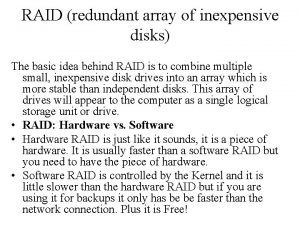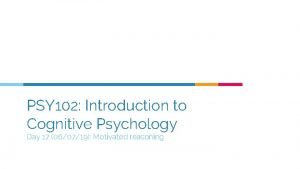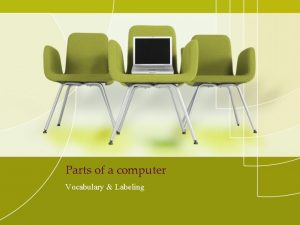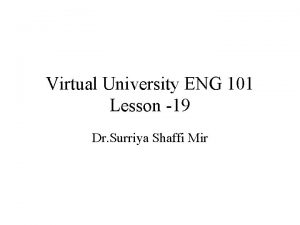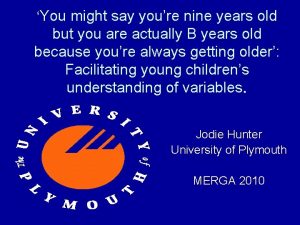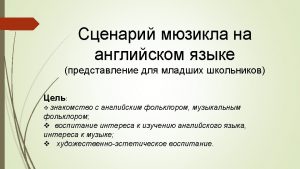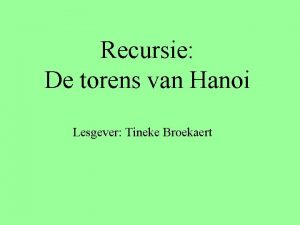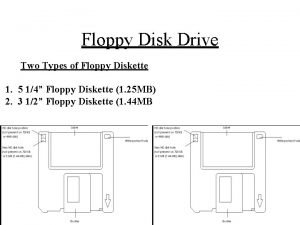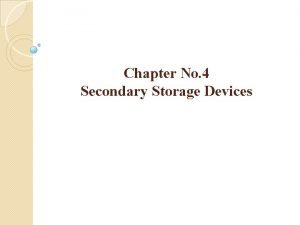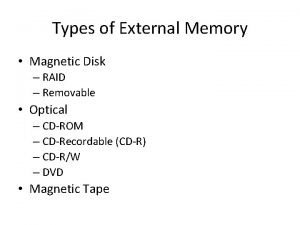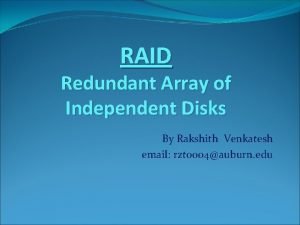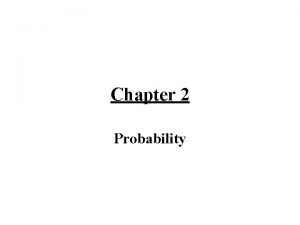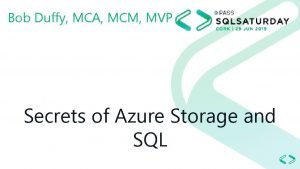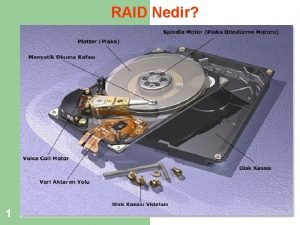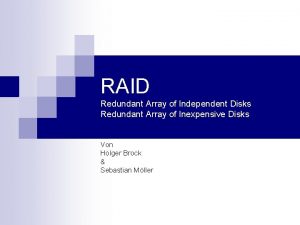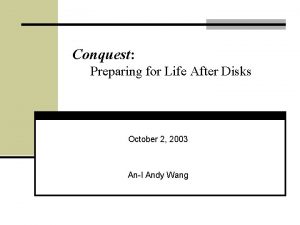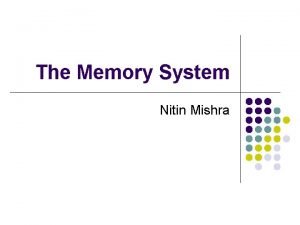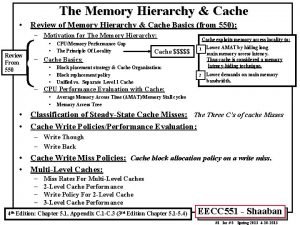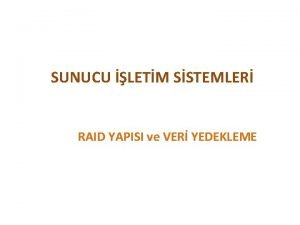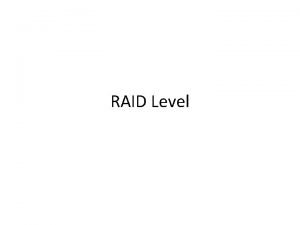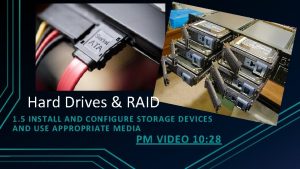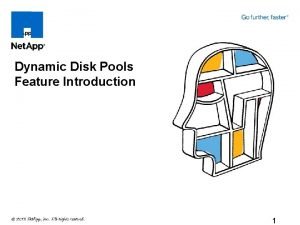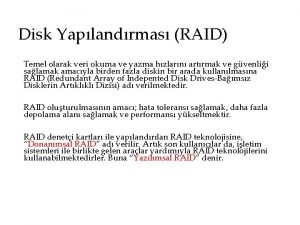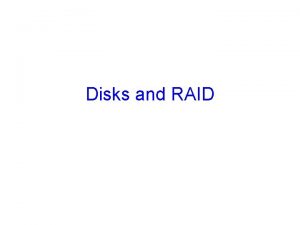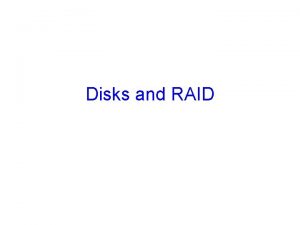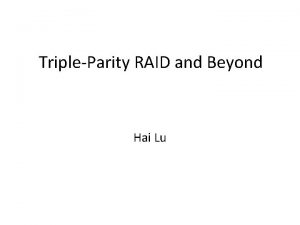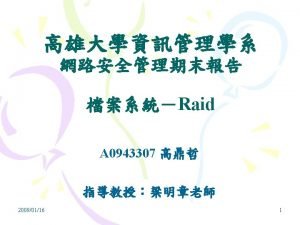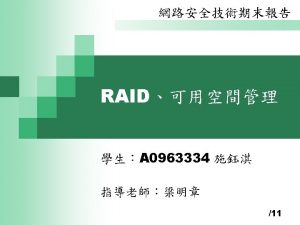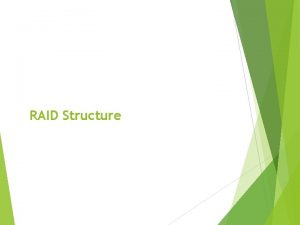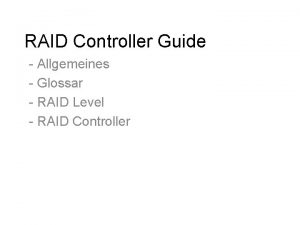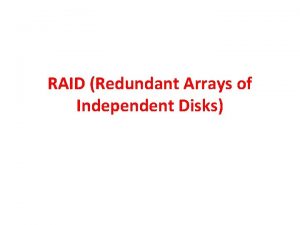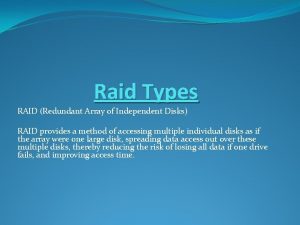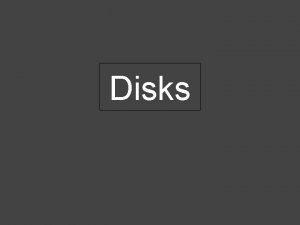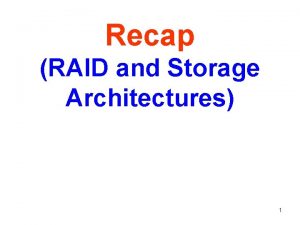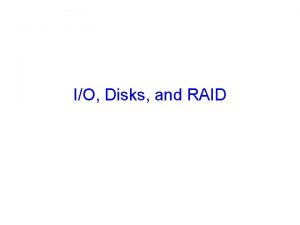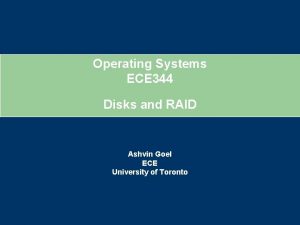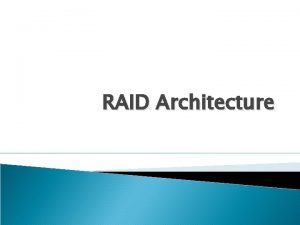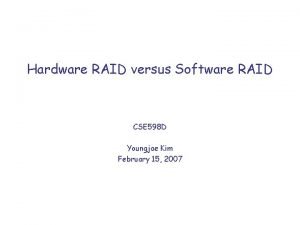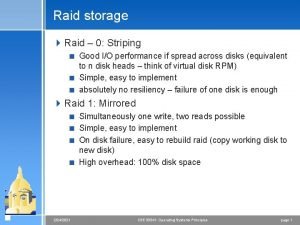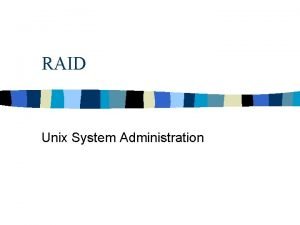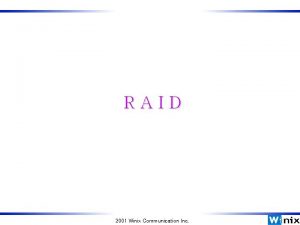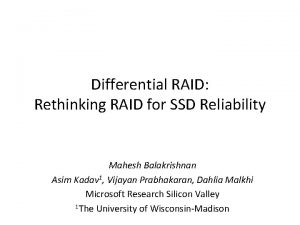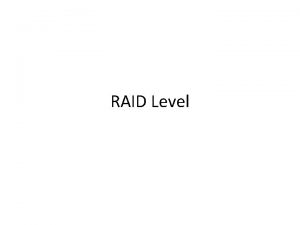Disks and RAID 50 Years Old 13 th












































- Slides: 44

Disks and RAID

50 Years Old! • 13 th September 1956 • The IBM RAMAC 350

• 80000 times more data on the 8 GB 1 -inch drive in his right hand than on the 24 -inch RAMAC one in his left…

What does the disk look like?

Some parameters • 2 -30 heads (platters * 2) – diameter 14’’ to 2. 5’’ • 700 -20480 tracks per surface • 16 -1600 sectors per track • sector size: – 64 -8 k bytes – 512 for most PCs – note: inter-sector gaps • capacity: 20 M-100 G • main adjectives: BIG, slow

• Disk overheads To read from disk, we must specify: – cylinder #, surface #, sector #, transfer size, memory address • Transfer time includes: – Seek time: to get to the track – Latency time: to get to the sector and – Transfer time: get bits off the disk Track Sector Seek Time Rotation Delay

Modern disks Capacity Barracuda 180 Cheetah X 15 36 LP 181 GB 36. 7 GB Disk/Heads 12/24 4/8 Cylinders 24, 247 18, 479 Sectors/track ~609 ~485 Speed 7200 RPM 15000 RPM Latency (ms) 4. 17 2. 0 Avg seek (ms) 7. 4/8. 2 3. 6/4. 2 Track-2 track(ms) 0. 8/1. 1 0. 3/0. 4

Disks vs. Memory • Smallest write: sector • Atomic write = sector • Random access: 5 ms – not on a good curve • Sequential access: 200 MB/s • Cost $. 002 MB • Crash: doesn’t matter (“nonvolatile”) • (usually) bytes • byte, word • 50 ns – faster all the time • 200 -1000 MB/s • $. 10 MB • contents gone (“volatile”)

Disk Structure • Disk drives addressed as 1 -dim arrays of logical blocks – the logical block is the smallest unit of transfer • This array mapped sequentially onto disk sectors – Address 0 is 1 st sector of 1 st track of the outermost cylinder – Addresses incremented within track, then within tracks of the cylinder, then across cylinders, from innermost to outermost • Translation is theoretically possible, but usually difficult – Some sectors might be defective – Number of sectors per track is not a constant

Non-uniform #sectors / track • Reduce bit density per track for outer layers (Constant Linear Velocity, typically HDDs) • Have more sectors per track on the outer layers, and increase rotational speed when reading from outer tracks (Constant Angular Velcity, typically CDs, DVDs)

Disk Scheduling • The operating system tries to use hardware efficiently – for disk drives having fast access time, disk bandwidth • Access time has two major components – Seek time is time to move the heads to the cylinder containing the desired sector – Rotational latency is additional time waiting to rotate the desired sector to the disk head. • Minimize seek time • Seek time seek distance • Disk bandwidth is total number of bytes transferred, divided by the total time between the first request for service and the completion of the last transfer.

Disk Scheduling (Cont. ) • Several scheduling algos exist service disk I/O requests. • We illustrate them with a request queue (0 -199). 98, 183, 37, 122, 14, 124, 65, 67 Head pointer 53

FCFS Illustration shows total head movement of 640 cylinders.

SSTF • Selects request with minimum seek time from current head position • SSTF scheduling is a form of SJF scheduling – may cause starvation of some requests. • Illustration shows total head movement of 236 cylinders.

SSTF (Cont. )

SCAN • The disk arm starts at one end of the disk, – moves toward the other end, servicing requests – head movement is reversed when it gets to the other end of disk – servicing continues. • Sometimes called the elevator algorithm. • Illustration shows total head movement of 208 cylinders.

SCAN (Cont. )

C-SCAN • Provides a more uniform wait time than SCAN. • The head moves from one end of the disk to the other. – servicing requests as it goes. – When it reaches the other end it immediately returns to beginning of the disk • No requests serviced on the return trip. • Treats the cylinders as a circular list – that wraps around from the last cylinder to the first one.

C-SCAN (Cont. )

C-LOOK • Version of C-SCAN • Arm only goes as far as last request in each direction, – then reverses direction immediately, – without first going all the way to the end of the disk.

C-LOOK (Cont. )

Selecting a Good Algorithm • SSTF is common and has a natural appeal • SCAN and C-SCAN perform better under heavy load • Performance depends on number and types of requests • Requests for disk service can be influenced by the file-allocation method. • Disk-scheduling algorithm should be a separate OS module – allowing it to be replaced with a different algorithm if necessary. • Either SSTF or LOOK is a reasonable default algorithm

Disk Formatting • After manufacturing disk has no information – Is stack of platters coated with magnetizable metal oxide • Before use, each platter receives low-level format – Format has series of concentric tracks – Each track contains some sectors – There is a short gap between sectors • Preamble allows h/w to recognize start of sector – Also contains cylinder and sector numbers – Data is usually 512 bytes – ECC field used to detect and recover from read errors

Cylinder Skew • Why cylinder skew? • How much skew? • Example, if – 10000 rpm • Drive rotates in 6 ms – Track has 300 sectors • New sector every 20 µs – If track seek time 800 µs 40 sectors pass on seek Cylinder skew: 40 sectors

Formatting and Performance • If 10 K rpm, 300 sectors of 512 bytes per track – 153600 bytes every 6 ms 24. 4 MB/sec transfer rate • If disk controller buffer can store only one sector – For 2 consecutive reads, 2 nd sector flies past during memory transfer of 1 st track – Idea: Use single/double interleaving

Disk Partitioning • Each partition is like a separate disk • Sector 0 is MBR – Contains boot code + partition table – Partition table has starting sector and size of each partition • High-level formatting – Done for each partition – Specifies boot block, free list, root directory, empty file system • What happens on boot? – BIOS loads MBR, boot program checks to see active partition – Reads boot sector from that partition that then loads OS kernel, etc.

Handling Errors • A disk track with a bad sector • Solutions: – Substitute a spare for the bad sector (sector sparing) – Shift all sectors to bypass bad one (sector forwarding)

RAID Motivation • Disks are improving, but not as fast as CPUs – 1970 s seek time: 50 -100 ms. – 2000 s seek time: <5 ms. – Factor of 20 improvement in 3 decades • • We can use multiple disks for improving performance – By Striping files across multiple disks (placing parts of each file on a different disk), parallel I/O can improve access time Striping reduces reliability – 100 disks have 1/100 th mean time between failures of one disk • • So, we need Striping for performance, but we need something to help with reliability / availability To improve reliability, we can add redundant data to the disks, in addition to Striping

RAID • A RAID is a Redundant Array of Inexpensive Disks – In industry, “I” is for “Independent” – The alternative is SLED, single large expensive disk • Disks are small and cheap, so it’s easy to put lots of disks (10 s to 100 s) in one box for increased storage, performance, and availability • The RAID box with a RAID controller looks just like a SLED to the computer • Data plus some redundant information is Striped across the disks in some way • How that Striping is done is key to performance and reliability.

Some Raid Issues • Granularity – fine-grained: Stripe each file over all disks. This gives high throughput for the file, but limits to transfer of 1 file at a time – coarse-grained: Stripe each file over only a few disks. This limits throughput for 1 file but allows more parallel file access • Redundancy – uniformly distribute redundancy info on disks: avoids load-balancing problems – concentrate redundancy info on a small number of disks: partition the set into data disks and redundant disks

Raid Level 0 • • • Level 0 is nonredundant disk array Files are Striped across disks, no redundant info High read throughput Best write throughput (no redundant info to write) Any disk failure results in data loss – Reliability worse than SLED Stripe 0 Stripe 1 Stripe 2 Stripe 4 Stripe 5 Stripe 6 Stripe 7 Stripe 8 Stripe 9 Stripe 10 Stripe 11 data disks Stripe 3

Raid Level 1 • Mirrored Disks • Data is written to two places – On failure, just use surviving disk • On read, choose fastest to read – Write performance is same as single drive, read performance is 2 x better • Expensive Stripe 0 Stripe 1 Stripe 4 Stripe 5 Stripe 8 Stripe 9 Stripe 2 Stripe 3 Stripe 0 Stripe 1 Stripe 6 Stripe 7 Stripe 4 Stripe 5 Stripe 6 Stripe 7 Stripe 10 Stripe 11 Stripe 8 Stripe 9 Stripe 10 Stripe 11 data disks Stripe 2 mirror copies Stripe 3

Parity and Hamming Codes • What do you need to do in order to detect and correct a one-bit error ? – Suppose you have a binary number, represented as a collection of bits: <b 3, b 2, b 1, b 0>, e. g. 0110 • Detection is easy • Parity: – Count the number of bits that are on, see if it’s odd or even • EVEN parity is 0 if the number of 1 bits is even – – – Parity(<b 3, b 2, b 1, b 0 >) = P 0 = b 0 b 1 b 2 b 3 Parity(<b 3, b 2, b 1, b 0, p 0>) = 0 if all bits are intact Parity(0110) = 0, Parity(01100) = 0 Parity(11100) = 1 => ERROR! Parity can detect a single error, but can’t tell you which of the bits got flipped

Parity and Hamming Code • • • Detection and correction require more work Hamming codes can detect double bit errors and detect & correct single bit errors 7/4 Hamming Code – – – – – h 0 = b 0 b 1 b 3 h 1 = b 0 b 2 b 3 h 2 = b 1 b 2 b 3 H 0(<1101>) = 0 H 1(<1101>) = 1 H 2(<1101>) = 0 Hamming(<1101>) = <b 3, b 2, b 1, h 2, b 0, h 1, h 0> = <1100110> If a bit is flipped, e. g. <1110110> Hamming(<1111>) = <h 2, h 1, h 0> = <111> compared to <010>, <101> are in error. Error occurred in bit 5.

• • • Bit 0 Raid Level 2 Bit-level Striping with Hamming (ECC) codes for error correction All 7 disk arms are synchronized and move in unison Complicated controller Single access at a time Tolerates only one error, but with no performance degradation Bit 1 Bit 2 data disks Bit 3 Bit 4 Bit 5 ECC disks Bit 6

Raid Level 3 • Use a parity disk – Each bit on the parity disk is a parity function of the corresponding bits on all the other disks • A read accesses all the data disks • A write accesses all data disks plus the parity disk • On disk failure, read remaining disks plus parity disk to compute the missing data Bit 0 Bit 1 Bit 2 Bit 3 Parity disk data disks Single parity disk can be used to detect and correct errors

Raid Level 4 • • Combines Level 0 and 3 – block-level parity with Stripes A read accesses all the data disks A write accesses all data disks plus the parity disk Heavy load on the parity disk Stripe 0 Stripe 1 Stripe 2 Stripe 3 P 0 -3 Stripe 4 Stripe 5 Stripe 6 Stripe 7 P 4 -7 Stripe 8 Stripe 9 Stripe 10 Stripe 11 P 8 -11 Parity disk data disks

Raid Level 5 • Block Interleaved Distributed Parity • Like parity scheme, but distribute the parity info over all disks (as well as data over all disks) • Better read performance, large write performance – Reads can outperform SLEDs and RAID-0 Stripe 1 Stripe 2 Stripe 4 Stripe 5 Stripe 6 Stripe 8 Stripe 9 P 8 -11 Stripe 3 P 4 -7 Stripe 10 data and parity disks P 0 -3 Stripe 7 Stripe 11

Raid Level 6 • Level 5 with an extra parity bit • Can tolerate two failures – What are the odds of having two concurrent failures ? • May outperform Level-5 on reads, slower on writes

RAID 0+1 and 1+0

Stable Storage • Handling disk write errors: – Write lays down bad data – Crash during a write corrupts original data • What we want to achieve? Stable Storage – When a write is issued, the disk either correctly writes data, or it does nothing, leaving existing data intact • Model: – An incorrect disk write can be detected by looking at the ECC – It is very rare that same sector goes bad on multiple disks – CPU is fail-stop

Approach • Use 2 identical disks – corresponding blocks on both drives are the same • 3 operations: – Stable write: retry on 1 st until successful, then try 2 nd disk – Stable read: read from 1 st. If ECC error, then try 2 nd – Crash recovery: scan corresponding blocks on both disks • If one block is bad, replace with good one • If both are good, replace block in 2 nd with the one in 1 st

CD-ROMs Spiral makes 22, 188 revolutions around disk (approx 600/mm). Will be 5. 6 km long. Rotation rate: 530 rpm to 200 rpm

CD-ROMs Logical data layout on a CD-ROM
 Raid redundant array of independent disks
Raid redundant array of independent disks How long is four score and seven years?
How long is four score and seven years? Sheep years to human years
Sheep years to human years 300 solar years to lunar years
300 solar years to lunar years Lydia is 48 years old single outspoken and very bright
Lydia is 48 years old single outspoken and very bright Computer parts labeling
Computer parts labeling Disks and tapes can be stored ------- a library. eng101
Disks and tapes can be stored ------- a library. eng101 Hobby o hobbie
Hobby o hobbie New years old is new again
New years old is new again Hello
Hello Genesis 17:1-4
Genesis 17:1-4 Jack hartmann january
Jack hartmann january You are nine years old
You are nine years old Xxxbritt
Xxxbritt Despite being thousands of years old
Despite being thousands of years old Under 15 years old
Under 15 years old Juvenile justice and welfare act of 2006
Juvenile justice and welfare act of 2006 Dusk by saki summary
Dusk by saki summary Once upon a time lived
Once upon a time lived Once upon a time there lived an old man and an old woman
Once upon a time there lived an old man and an old woman Tower of hanoi 4 disks
Tower of hanoi 4 disks Floppy disk
Floppy disk Magnetic secondary storage
Magnetic secondary storage Types of external memory
Types of external memory Redundant arrays of independent disks
Redundant arrays of independent disks Disks of polycarbonate plastic from a supplier are analyzed
Disks of polycarbonate plastic from a supplier are analyzed Aka.ms.sqlcapacity
Aka.ms.sqlcapacity Unraid nedir
Unraid nedir Redundant array of independent disks
Redundant array of independent disks Conquest data disks
Conquest data disks How old is your name
How old is your name Once upon a time there lived a family of bears
Once upon a time there lived a family of bears Lindisfarne raid primary sources
Lindisfarne raid primary sources Cache tag size raid 0
Cache tag size raid 0 Cache tag size raid 0
Cache tag size raid 0 Jelena raid
Jelena raid Raid yedekleme
Raid yedekleme Raid 6 adg
Raid 6 adg Raid duplexing
Raid duplexing Dynamic drive pool
Dynamic drive pool Raid 5 nasıl yapılır
Raid 5 nasıl yapılır Calcolo raid 5
Calcolo raid 5 Chapter 21 a dividing nation answer key
Chapter 21 a dividing nation answer key Harpers ferry raid apush
Harpers ferry raid apush Raid system of data protection
Raid system of data protection
